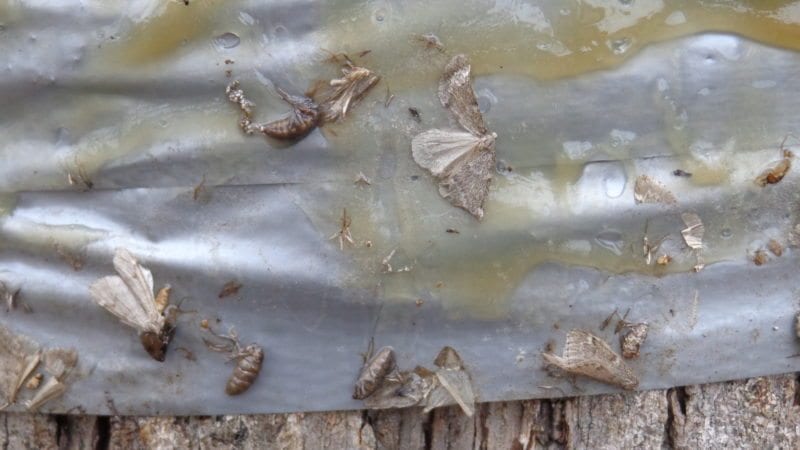NEWS
Cankerworm Attack – Fight Back!

Tree Banding Fights Cankerworms.
Fall cankerworm caterpillars attack in the April; now is the time to fight back. Looking like small green or brown inch worms, these creatures feed on the leaves of several species of popular deciduous trees, but particularly willow oaks. No one knows why Davidson has had a growing infestation for the past 20 years, or why this past spring saw a relatively light infestation. Some observers have speculated that the cold snap in early April held the caterpillar count down, but I observed a lighter capture in my sticky bands last fall. No matter. The little guys can still bounce back and defoliate a tree, leaving it vulnerable to death from other common stressors such as summer drought, another insect, disease, or excessive pruning.
Now the perfect time to act to reduce the depredations of these creatures. The process is messy, but it will help defend your trees. Concentrate on the caterpillars’ favorite foods—oaks of all species, maples, and elms. The caterpillars will not attack tulip poplars or conifers. Likewise, concentrate your efforts on trees aver 20’ tall. Shrubbery and very young, i.e., still very small, trees can be protected by a different method.
Tree banding is the only method homeowners can successfully use to control fall canker worms on large trees. (We don’t have the equipment to successfully spray a large tree. Besides, it would be prohibitively expensive to spray all the large trees on most homeowners’ property.) Trees with heavily furrowed or ridged bark will require the full treatment described below.
Materials:
Staples, staple gun, duct tape, elbow length, disposable gloves, roofing felt, insulation batting, Tanglefoot ™ glue, and a disposable putty knife. (Tanglefoot was in short supply last year; it is now easy to obtain.)
Procedure:
- Install a strip of cotton batting around the tree trunk about 3-4’ above the ground but below the lowest branch of the tree. Work it into the furrows of the bark.
- Attach a 4” wide band of roofing felt over the batting and fasten to tree with staples. Do not staple young trees or trees with thin bark—use duct tape instead. Some authorities insist you can just use outdoor grade duct tape instead of the roofing felt and staples. This is certainly an easier and cheaper alternative, but in my experience, the duct tape eventually detaches from the tree.
- Wearing the gloves and using the putty knife, apply a 1/8” film of Tanglefoot to the roofing felt or duct tape.
The wingless female moths emerge from the ground when the nighttime temperature dips below 30 degrees for at least two nights in a row, usually in mid-December, mate, and then climb trees to lay their eggs. The Tanglefoot™ band will stop most of them from ever reaching their destination.
Whatever banding method you use, remove the band early in March. If left in place, the band will collect moisture underneath it, creating a favorable environment for other infestations. Further, young trees banded with duct tape may be strangled when they start to grow.
It is obviously impracticable to band every tree, much less every shrub in your yard. Shrubs may be treated in the spring when the caterpillars emerge with any insecticide that is labeled as being safe and effective for use against canker worms or caterpillars, in general. Non-toxic insecticidal soap is also effective as a spray, but it must be applied about 3 times per week during the munching season. Whatever insecticide you use, use it only in accordance with the instructions on the label. These instructions not only direct the effective way to use the insecticide, they direct the environmentally safe and approved method of application. Another non-toxic spray is the bacterium known as Bt, sold under the brand name Thuricide.
Tom Watson
Tom Watson is a Volunteer Extension Master Gardener in Mecklenburg County. He has also received a Certificate in Native Plants from UNC-C and a Certificate in Horticulture Technology--Residential Landscape Design from CPCC. He and his wife, Sue Bartlett, own The Cedars Davidson Bed & Breakfast.


